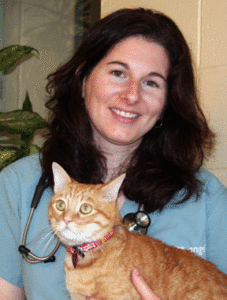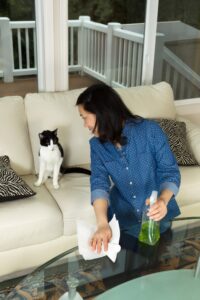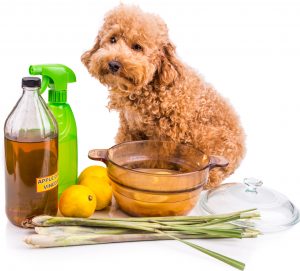-
Adopt
-
Veterinary Care
Services
Client Information
- What to Expect – Angell Boston
- Client Rights and Responsibilities
- Payments / Financial Assistance
- Pharmacy
- Client Policies
- Our Doctors
- Grief Support / Counseling
- Directions and Parking
- Helpful “How-to” Pet Care
Online Payments
Referrals
- Referral Forms/Contact
- Direct Connect
- Referring Veterinarian Portal
- Clinical Articles
- Partners in Care Newsletter
CE, Internships & Alumni Info
CE Seminar Schedule
Emergency: Boston
Emergency: Waltham
Poison Control Hotline
-
Programs & Resources
- Careers
-
Donate Now
 Mara Ratnofsky, DVM
Mara Ratnofsky, DVM
Angell General Medicine Service
angell.org/generalmedicine
617-522-7282
For many people, the arrival of spring brings with it the desire for a fresh start. We throw open the windows, empty out our closets, and scrub all the surfaces in the house. If you share your home with a dog or cat, it is important to know that some common household cleaners can be toxic to them.
 According to the leading nationwide Animal Poison Control Center, a substantial percentage of calls to their hotline are the result of a pet’s exposure to a cleaning product such as bleach, a detergent, or a disinfectant. Accidental exposure is sometimes the result of a curious dog poking his nose where it doesn’t belong, but since cats and dogs groom with their mouths they routinely ingest residues of many environmental toxins. A 2008 study conducted by the Environmental Working Group measured the level of common chemicals in the urine and blood of dogs and cats. Forty-three out of 48 of these chemicals were found at significantly higher levels in dogs and cats than in the typical human.
According to the leading nationwide Animal Poison Control Center, a substantial percentage of calls to their hotline are the result of a pet’s exposure to a cleaning product such as bleach, a detergent, or a disinfectant. Accidental exposure is sometimes the result of a curious dog poking his nose where it doesn’t belong, but since cats and dogs groom with their mouths they routinely ingest residues of many environmental toxins. A 2008 study conducted by the Environmental Working Group measured the level of common chemicals in the urine and blood of dogs and cats. Forty-three out of 48 of these chemicals were found at significantly higher levels in dogs and cats than in the typical human.
Below are some common household cleaners and the specific risks they present to our pets.
Acids (toilet bowl cleaners, pool sanitizers)
These products have a low pH which can cause localized tissue damage on contact. Ingestion can result in vomiting (sometimes with blood), ulcers in the mouth and esophagus, and intense pain. The pain may help limit the amount of exposure. A splash in the eye can damage the cornea.
Alkalis (drain openers, dishwasher detergents, toilet bowl cleaners, swimming pool products)
Alkalis are products with a high pH. They can cause severe tissue damage, vomiting with blood, fever, and excessive salivation. These products don’t cause much pain on initial contact, so exposures may be more prolonged. It may take several hours before signs of pain and inflammation are evident, and the full extent of the damage done may not be apparent for 12 hours.
Bleaches (chlorine and color-safe)
Depending on the route of exposure, bleach can cause prolonged vomiting, burns to skin, coughing, and trouble breathing.
Detergents (dishwashing soap, various household cleaners)
Detergents can be very irritating to the gastrointestinal tract and eyes. Signs of ingestion are usually mild vomiting and diarrhea, although ingestion of large quantities can result in more severe stomach upset.
Cationic Detergents (fabric softeners, sanitizers)
Ingestion of these types of detergents can also cause vomiting and diarrhea. In addition, exposure to cationic detergents can be toxic to the nervous system. Depression, seizures, muscle weakness, and coma have been reported following exposure.
 Safer Alternatives
Safer Alternatives
While exposure to any cleaner can potentially cause mild irritation, there are some products on the market that are relatively pet-safe. Nature’s Miracle Stain and Odor Remover, OdoBan Neutral pH floor cleaner, Seventh Generation laundry detergent, Simple Green All Purpose Cleaner, and many other products are specifically marketed to be safe for people, pets, and the environment. Alternatively, many common pantry ingredients can be used to make effective and fairly safe cleaners. Vinegar diluted with water (9 parts water : 1part white vinegar) can be used as an all-purpose surface cleaner/disinfectant, and baking soda mixed into a paste with mild soap is an effective scrubbing agent. Homemade dishwasher detergent can be made by mixing 3 parts citric acid, 3 parts super washing soda, 1 part baking soda and 1 part sea salt.
Preventing exposure, whether by switching to a less toxic product or by installing child safety locks, is obviously ideal. However, if you suspect that your pet is suffering from exposure to a toxic cleaning product, seek veterinary attention immediately. Bring the product container with you if possible.
For information about Angell’s General Medicine service, please visit www.angell.org/generalmedicine or call 617-522-7282.